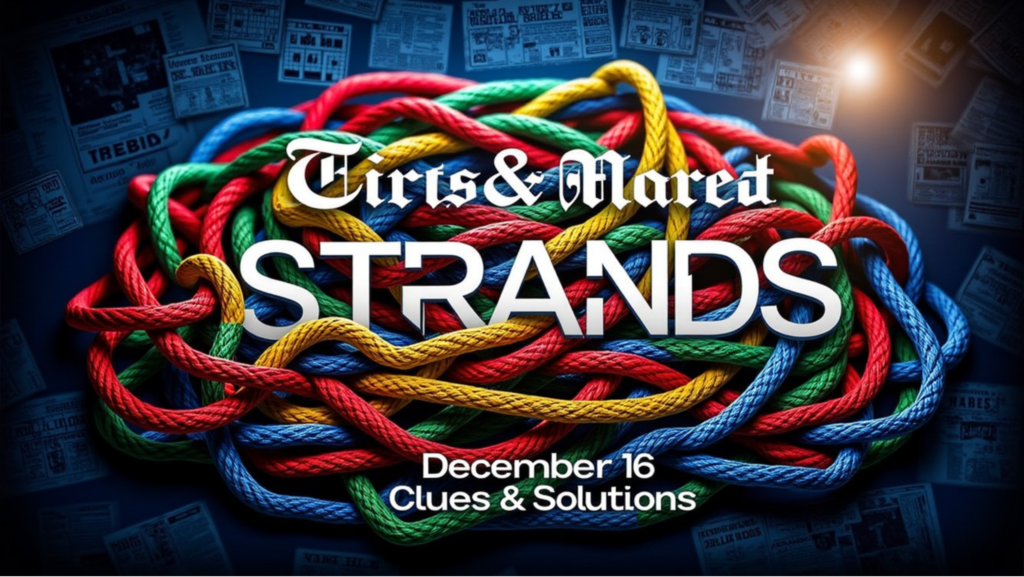One of the most famous puzzles to all puzzle fan and beloved word puzzle puzzle fan is no doubt New York Times Strands puzzle. Crypto is just the perfect challenge, giving cryptic clues to be deciphered in the right way to answer. If you want to know the answers to the day questions, well this post will be beneficial for you, because it will bring the *NYT Strands clues and solutions for December 16 of the day. With today’s post, anyone who’s a solver, be it senior or fresh, will find these clues easier.
the NYT Strands Puzzle
The New York Times word game for today is the NYT Strands. Each day, players have to figure out word-based clues. It’s usually wordplay, pop culture, historical knowledge, or tough riddles—something with wordplay, pop culture, historical knowledge, or tricky riddles in general. The Strands puzzle with the clues and stuff does a great job of working on understanding the structure of the clues in a crossword and looking for patterns in a crossword because you have to actually pay attention to the details, but if you continue trying, it’s a fantastic puzzle.
These puzzles are not too difficult either, and you can play starting from a beginner skill solver to someone at a novice skill level. If you are a newbie and trying to solve the old puzzles first, it will ease you into the hard issues and the main tricks.
Stranded NYT (And Not Sudoku)
Before diving into the solutions for December 16, it’s important to understand the best approach to solving these types of puzzles:
- Read the clues carefully. You will know where to find the right answer too. So these are the words that they call ”’anagram’,’reversal’, or ‘hidden word’, for which they want a particular arrangement of letters in an array.
- Break Down Each Clue: The wordplay of Strands Clues is more often than not literal, but there’s yet more to it than that. Therefore, first you should separate the definition from the rest of the clue, then see it as individual pieces.
- Use the Puzzle’s Structure: The idiom is the idiom or, at least, the patterns crossword puzzles almost always produce.
- Check for Crossword Shortcuts: Usually Roman numbers or abbreviations or the phrase is set up in the same non‐standardized format.
Since we’ve done the basics of figuring out how to solve the puzzle, let’s have a look at each of these NYT Strands Clues and Solutions for December 16 (modified to fit the strategy):
December 16 NYT: Clues and Answers
**1. Clue: **Fill in the blanks: (4 letters): You are a __ person.
*Solution: “Be”*
Easy. And one of those sayings people say all the time that it’s good to consider is might as well be: it’s something to solicit answers from your gut that maybe you never would have thought otherwise.
**2. Clue: “Worn out shoes” **
Solution: “Tired”
Probably one of the best word play I ever heard. Aside from it, “tired” also means “worn out shoes” and “exhausted”. Sometimes they’re so like this trying to trick you with a double meaning.
**3. Clue: ‘Again, the ‘….. of the round table’
*Solution: “King”*
Across Camelot these figures of legend. We surely know something of the Arthurian legends. The King was certainly the most central character at the round table.
**4. Clue: That’s a 3 letter word for ‘stage performer’.
*Solution: “Acts”*
Since this is the first clue, let’s keep it simple: That’s what it uses of verb ‘to perform’ or ‘to perform’ on the stage. All the NYT Strands puzzles — the short, simple, quick play ones.
**5. Clue: One letter social media icon.
*Solution: “IG”*
The popular abbreviation Instagram has almost grown into ‘social media’ essentially. They’re taking modern culture and average modern situations and slang from modern era and plug it all in.
**6. Clue: ‘Can’ common browser.
*Solution: “Edge”*
People actually started taking Microsoft Edge seriously – they saw how popular it is. Some puzzles reference modern tech, so although you don’t have to know how to program, it’s nice to know about where software is right now, so that you can solve those along that much faster.
**7. Clue: a clue was cryptic (7)
*Solution: “Logic”*
The metaclue is just that you solved a puzzle. The cool bit. It is possible to derive cryptic clues with logic. One way the act of solving can pop up in a clue is like this.
We’ve now come to know that it is the sun that reflects its light in the moon when we illuminate that in the night; just so that you get a relevant example, we have also grown in the thought that we have sun in the day and moon in the night, but now we know. That’s a hard clue; you have to put the pieces out on the outside corners of associations.
From the Compile of Ideas for the Strands Puzzle.
Strands Puzzle Response
They vary; some are easy, some you won’t get. Here are a few quick tips to help you get through even the toughest of clues:
- Stay Patient: If you don’t understand that, then just hop around to the next clue, and then come back to get it! You just needed an extra pair of eyes to solve it sometimes.
- Use a dictionary or thesaurus: These aren’t cheating per se, but you can look at answers, or sometimes discover new answers, with them.
- Join a Puzzle Community: Finally, if talking to other people who you may well meet during the course of trying to help you pursue an interest in the same subject further widens your mind and gives you some ideas or strategies you never thought of, then talk to them.
- Practice Regularly: And sure, when you’re working on a puzzle for Strands puzzles, you do spend time working and there will be necessarily more patterns that you see, more clues that you find, more themes.
Conclusion
Deciphering NYT Strands clues is really more part art than part art of being logical, knowing the culture, or trying to think outside the box. Depending on the puzzle solutions, clues are very easy to a bit more difficult over the weekend of December 16. With the tips above and trying to work out if you can spot if there are any recurring themes (and if someone’s being sly with the word play), it should make the puzzles of each day just a little bit easier. Solve, start, and stay curious while you keep solving as you pro so solve.
Get the latest puzzles and solutions from the The New York Times (and practice every day to hone your skills). Happy solving!




